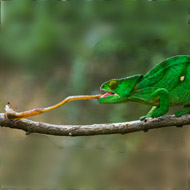
Findings may benefit the field of biomimetrics
A team of scientists from the University of Oxford have devised a mathematical model to explain how a chameleon is able is unravel its tongue so fast.
Researchers from the Mathematical Institute, together with a team from Tufts University in the USA, formed a system of differential equations to capture the mechanics of energy build-up and ‘extreme acceleration’ of the reptile’s tongue.
It is hoped that their study, published in Proceedings of the Royal Society A, will be useful in the field of biomimetics - the imitation of nature for the purpose of solving complex human problems.
Explaining the work, lead author Derek Moulton said: “If you are looking at the equations they might look complex, but at the heart of all this is Newton’s Second Law - the sort of thing that kids are learning in A-levels, which is simply that you’re balancing forces with accelerations.
“In mathematical terms, what we’ve done is used the theory of non-linear elasticity to describe the energy in the various tongue layers and then passed that potential energy to a model of kinetic energy for the tongue dynamics.”
It is said that if a chameleon’s tongue was a car it could accelerate from 0 to 60 mph in 1/100th of a second.
The team believe that special collagenous tissue found within the chameleon’s tongue is the secret to its effectiveness. The tissue surrounds a bone at the core of the tongue and is surrounded itself by a muscle.
“The muscle - the outermost layer- contracts to set the whole thing animation,” commented Professor Moulton. “We’ve modelled the mechanics of the whole process; the build-up and release of energy.”



 The RCVS has announced a new version of its 1CPD mobile app, with enhanced features for veterinary surgeons and veterinary nurses to record their continuing professional development.
The RCVS has announced a new version of its 1CPD mobile app, with enhanced features for veterinary surgeons and veterinary nurses to record their continuing professional development.